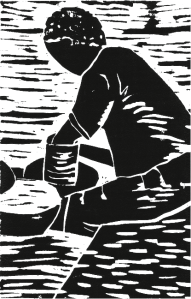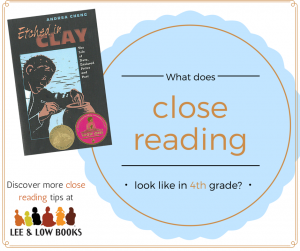 Jaclyn DeForge, our Resident Literacy Expert, began her career teaching first and second grade in the South Bronx, and went on to become a literacy coach and earn her Masters of Science in Teaching. In her column she offers teaching and literacy tips for educators.
Jaclyn DeForge, our Resident Literacy Expert, began her career teaching first and second grade in the South Bronx, and went on to become a literacy coach and earn her Masters of Science in Teaching. In her column she offers teaching and literacy tips for educators.
 Over the past several weeks, I’ve been modeling how to do a close reading at several different grade levels. Next up: Close Reading in Fourth Grade using the T level text Etched in Clay: The Life of Dave, Enslaved Potter and Poet written and illustrated by Andrea Cheng, out this January!
Over the past several weeks, I’ve been modeling how to do a close reading at several different grade levels. Next up: Close Reading in Fourth Grade using the T level text Etched in Clay: The Life of Dave, Enslaved Potter and Poet written and illustrated by Andrea Cheng, out this January!
One way to structure close reading questioning is to use the format laid out by the Institute for Learning of the University of Pittsburgh. Under their framework, students read the text selection four times: first, to get the gist; second, to find significant moments or ideas; third, to interpret the ideas in the text; and finally, to analyze the author’s methods (craft). Here’s an example of how to plan out your questions for close reading of the introduction through the first 13 pages of Etched in Clay:
1st reading (read to get the gist):
- Who is Dr. Abner Landrum? What have we learned about him? What can we infer about him so far? Cite evidence from the text to support your answer.
- Who is Harvey Drake? What have we learned about him? What can we infer about him so far? Who is Amos Landrum? How is Harvey different than Amos? Cite evidence from the text to support your answer.
- Who is Dave? What have we learned about him? What can we infer about him so far? How does he feel about the work he’s been given to do? About being renamed “Dave”? About his first pottery lesson? Cite evidence from the text to support your answer.
- What major events have occurred so far? How much time has passed? During what period in history are the events taking place? How do you know? What do you know about this period in American history that can help your reading of the text? Cite evidence from the text to support your answer.
- What was important to Dr. Abner Landrum? Cite evidence from the text to support your answer.
2nd reading (read to find significant moments or ideas):
- What is the most important thing you learned or that happened in this section of the text? Why is it significant? Cite evidence from the text to support your answer.
3rd reading (read to interpret ideas):
- In the poem “Augusta Auction”, how does the auctioneer view Dave? How does Harvey Drake view Dave? What can you infer about how Harvey Drake feels about slavery? Cite evidence from the text to support your answer.
- On page 7 in the poem “Augusta Auction,” Harvey Drake describes the slaves at auction as follows: “The Negro mothers wail/while their children cling to them/like melons to their vines.” Cheng’s passage serves two purposes, one descriptive and one historical/sociological. Discuss the dual meanings of the image she creates. Cite evidence from the text to support your answer.
4th reading (read to analyze the author’s methods/craft):
- How is this text organized? How is it different than other biographical texts or historical fiction you’ve read? How is it similar? Cite evidence from the text to support your answer.
- Who is the audience for this text? Why does Andrea Cheng consistently shift narrator? What effect does this have on how the story is told and how the information is presented? Cite evidence from the text to support your answer.
- What are some of the strongest images Cheng has created so far? How do these images set the mood for the piece? Cite evidence from the text to support your answer.
By asking students to ground their responses in the text by citing text-based support for their answers, the following Common Core Standard is addressed:
Reading Literature, Grade 4, Key Ideas and Details, Strand 1: Refer to details and examples in a text when explaining what the text says explicitly and when drawing inferences from the text.
How does close reading look in your classroom? Any tricks and tips to share?
 Further reading on teaching literacy in Fourth Grade:
Further reading on teaching literacy in Fourth Grade:
- Three Ways To Teach Etched In Clay
- How To Compare And Contrast With The Common Core In Fourth Grade
- Integrating Reading, Writing, Speaking & Listening In Grades 4-5
- Using Dual Language And Bilingual Books In Third And Fourth Grade
Further reading on Close Reading series:
- What is close reading?
- What does close reading look like in Kindergarten?
- What does close reading look like in First Grade?
- What does close reading look like in Second Grade?
- What does close reading look like in Third Grade?
- What does close reading look like in Fifth grade
- How to teach close reading using a RECIPE
- Close reading with book illustrations
Further reading on Etched in Clay:


A rich, informative entry. Thank you! I have one question: What is the time from over which these 4 readings occur?
Thanks in advance for any input as I try to improve my practice.
Good question!! The timing depends on how much time you have allotted for the reading block in question. In the beginning, when students aren’t super used to the close reading framework, it can take more than one session to get through all four readings, and that’s totally ok!! I always tell the teachers I work with that it’s the depth of conversation and the rigor of student discussion/responses that I’d be concerned with, not how long it takes, since the focus is on critical rather than surface-level thinking. As students get used to handling increasingly complex text, this process of constantly going back to the text and answering this level of question should streamline itself. I hope I answered your question 🙂
Can this close reading activity be done as a read aloud if enough copies are not available for each student?
Etched in Clay: The Life of Dave, Enslaved Potter and Poet